Capital University of Economics and Business
Capital University of Economics and Business (simplified Chinese: 首都经济贸易大学; traditional Chinese: 首都經濟貿易大學; pinyin: Shǒudū Jīngjì Màoyì Dàxué) (often referred to as CUEB) is a modern, multi-disciplinary financial and economic university in Beijing, China. Founded in 1956 when the Ministry of Education founded the Beijing Economics Institute. In 1995, The Beijing government combined the Beijing Economics Institute and the Beijing Finance and Trade Institute creating Capital University of Economics and Business. CUEB is one of Beijing's three key universities, a member of Beijing - Hong Kong Universities Alliance.
首都经济贸易大学 | |
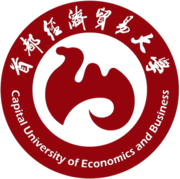 Capital University of Economics and Business | |
| Motto | 崇德尚能 经世济民 chóng dé shàng néng jīng shì jì mín |
|---|---|
Motto in English | "Advocate morality, value competence, strategize national development, and serve the people"[1] |
| Type | Public |
| Established | 1956 |
| President | Fu Zhifeng |
Academic staff | 750 |
Administrative staff | 1459 |
| Students | 20,436 |
| Undergraduates | 9,528 |
| Postgraduates | 2,310 |
| 170 | |
Other students | 8,598 |
| Location | , , |
| Colours | Red |
| Website | University website |
| [[File:|CUEB logo with name]|250px]] | |

History
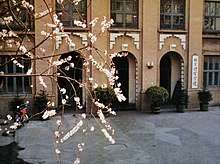
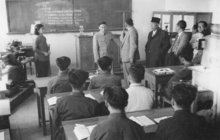
Capital University of Economics and Business is a key university in Beijing. On 24 March 1995, the National Education Commission approved the merger of the Beijing Institute of Economics and the Beijing Institute of Finance and Trade. The name of the school was designated as the Capital University of Economics and Business.
The predecessor of the Beijing Institute of Economics was the Beijing Labor Cadre School and the Beijing Experimental Workers Technical School, which were established in 1956. The Beijing Experimental Workers Technical School was relocated from Beijing to the Second Machinery Department Shenyang 211 Technical School. In October 1958, the Ministry of Labor approved the merger of the two schools to form the Beijing Labor College. In 1962, the Beijing Labor College was closed. In February 1963, the State Council approved the establishment of the Beijing Institute of Engineering Economics based on the Beijing Institute of Labor. On 7 June, the State Council approved the change of the Beijing Institute of Engineering Economics to the Beijing Institute of Economics. The school was closed during the Cultural Revolution. On 22 April 1974, the Beijing Economic College was established with the approval of the State Council. In 1986, the Beijing Institute of Economics was listed as a key university in Beijing.
The predecessor of Beijing Finance and Trade College is the Beijing Municipal Finance and Trade Cadre School established in 1958. The Beijing Municipal Finance and Trade Cadre School was established by the merger of Beijing Commercial Cadre School, Beijing Commercial Workers School, Beijing Food Cadre School, Beijing Supply and Marketing Cooperative Cadre School, Beijing Service Bureau Staff Training Class, and Bank of Beijing Training Class. On 15 March 1960, the General Office of the Beijing Municipal People's Committee approved the establishment of the Beijing Finance and Trade Secondary Professional School. In August 1962, Beijing Municipal Finance and Trade School operated independently. The school was abolished during the Cultural Revolution. In October 1972, the Beijing Finance and Trade School was established. In 1973, it was established and named "Beijing Finance and Economics School". In 1975, it was renamed "Beijing Finance and Trade School." On 28 December 1978, the Ministry of Education issued the "Notice on Consent to Reinstatement and Addition of a Group of Ordinary Colleges and Universities", and added the Beijing Finance and Trade College as an ordinary higher education institution.[2]
Campus
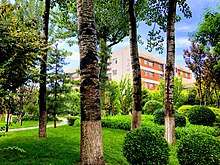
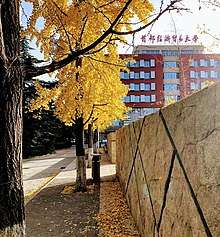
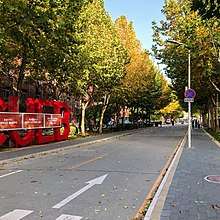
The two campuses are collectively 360,000 square yards and have a campus library that houses over 1.6 million books, and more than 2,500 periodicals in both Chinese and foreign languages. The original Hongmiao campus is located between the East 3rd and 4th ring roads, and is a 5-minute walk to Beijing's Central Business District (CBD). The main campus is located between the southwest 3rd and 4th ring roads in the Jijiamiao area of the Fengtai distinct of Beijing.
Academic
Currently the University consists of more than 30 colleges and departments and offers more than 30 Undergraduate degrees, 28 master's degrees including MBA, and 9 Doctoral programs.
The university's key areas of research are in Applied Economics, Labor Economics, Enterprise Management, Industrial Economics, Banking, and Finance.
CUEB employees 750 instructors for the programs, of those 239 hold doctoral degrees. Among CUEB's 127 full professors are 9 who have received distinctions from either the Beijing or Chinese government. The remaining instructors are either associate professors (312) or advisers for the doctoral and graduate students (294).
CUEB has founded over 25 economic research centers and institutes that focus on a wide range of areas including the World Trade Organization, Enterprise Development, Social Security, Real Estate Development.
Each year CUEB publishes 4 academic journals, with the "Research of Economics and Management" being one of the highest rated journals in the China and the Chinese Social Sciences Citation Index (CSSI).
In the 8th issue Philosophy and Social Science of Beijing 5 papers from CUEB faculty were honored with 1 being declared "first class" by the committee. The paper was also selected by the Ministry of National Education as the "Best Book" for the 14th issue, and was chosen by the Chongqing Municipality to be awarded the "first class excellent achievement prize.
Administration
The administrative framework of the university is as follows:[3]
Departmental Structure
- College for Urban Economics and Public Administration
- The College of Business Administration
- School of Economics
- School of Accounting
- School of Labor Economics
- School of Culture and Communication
- School of Information
- School of Safety and Environmental Engineering
- School of Public Finance and Taxation
- School of Law
- School of Finance
- The school of Statistics
- School of Foreign Studies
- Overseas Chinese College
- School of Marxism Studies
- International School of Economic Management
- School of International Education
- School of Continuing Education
- MBA Education Center[4]
International exchange
International Partners
Asia
Taiwan Region
Kaohsiung First University of Science and Technology,
Soochow University,
Providence University,
University of Tainan,
Chengchi University.
Japan
Meijo University,
Aichi University.
Hong Kong SAR
Hong Kong Baptist University
North America
United States
American University,
Auburn University,
Boston University,
Florida State University,
Georgetown University,
North Carolina State University,
Ohio State University,
Rutgers, The State University of New Jersey,
SUNY Binghamton,
Syracuse University,
Temple University,
Texas A&M University,
University of California at San Diego,
University of Cincinnati,
University of Illinois at Chicago,
University of Maryland,
University of Michigan, Ann Arbor,
University of Texas,
University of Utah,
University of Washington.
Canada
ST. Francis Xavier University,
University of Victoria,
Laurentian University,
Université de Montréal,
South America
Argentina
University of Buenos Aires
Europe
German
Furtwangen University of Applied Sciences,
Steinbeis-Hochschule-Berlin.
United Kingdom
The University of Manchester,
University of Essex,
University of Northampton,
Plymouth University.
Sweden
Vaxjo (Linnax) University,
Uppsala University.
Finland
Seinajoki University of Applied Science,
Haaga-Helia University of Applied Sciences.
France
Université Paris Diderot,
ESC Brest,
ESC Rennes,
ESC Clermont-FerrandAdvancia-Negocia (Novancia),
Université de Saint-Étienne,
Université François Rabelais,
Université Toulouse II,
Universite Toulouse I.
Ireland
Dublin City University Athlone Institute of Technology
Poland
Poznan University of Economics,
Warsaw School of Economics.
Hungary
Eotvos Lorand University
Oceania
Australia
University of Canterbury,
Queensland University of Technology,
Deakin UniversityGriffith University.
Notable people
Notable alumni include:
- Bei Ling - Chinese Misty Poet
- Maggie Wu - Chief Financial Officer of Alibaba Group
- Yang Xiaochao - Secretary General of the Central Commission for Discipline Inspection
References
- https://english.cueb.edu.cn/about/index.html
- "Archived copy". Archived from the original on 2013-11-19. Retrieved 2014-01-09.CS1 maint: archived copy as title (link)
- "Archived copy". Archived from the original on 2009-03-26. Retrieved 2009-02-02.CS1 maint: archived copy as title (link)
- https://english.cueb.edu.cn/about/organization/index.html
External links
- Capital University of Economics and Business Official Website (in Chinese)
- Capital University of Economics and Business Official Website